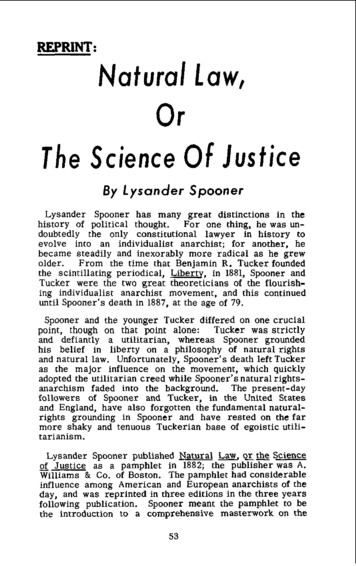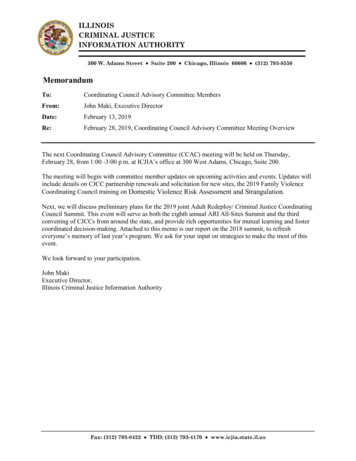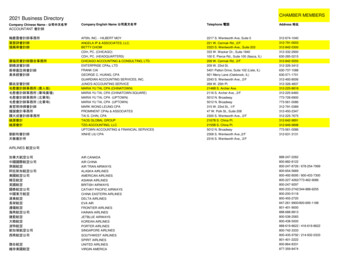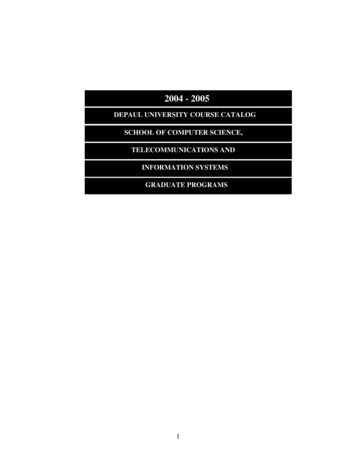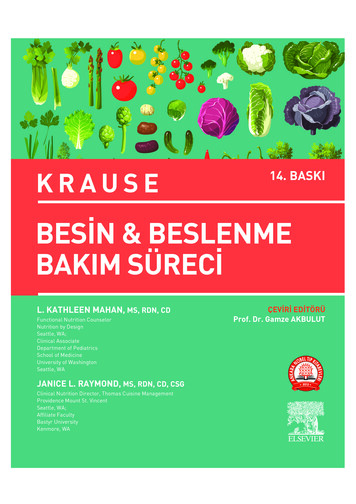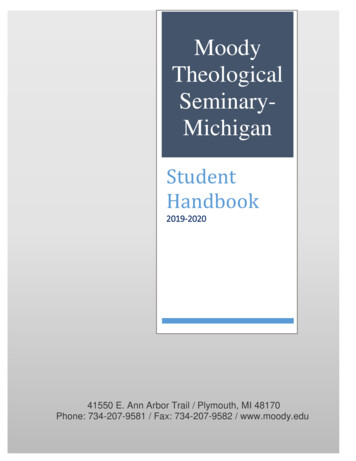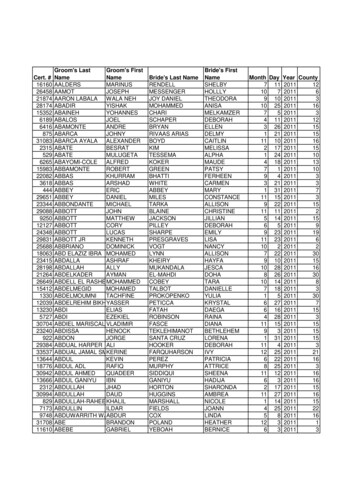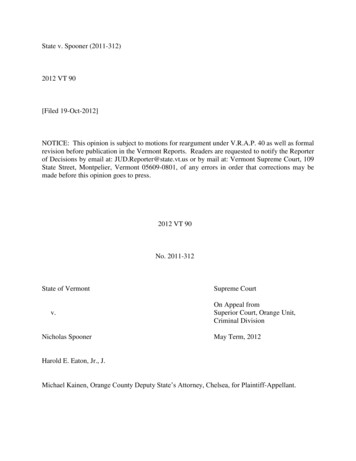
Transcription
State v. Spooner (2011-312)2012 VT 90[Filed 19-Oct-2012]NOTICE: This opinion is subject to motions for reargument under V.R.A.P. 40 as well as formalrevision before publication in the Vermont Reports. Readers are requested to notify the Reporterof Decisions by email at: JUD.Reporter@state.vt.us or by mail at: Vermont Supreme Court, 109State Street, Montpelier, Vermont 05609-0801, of any errors in order that corrections may bemade before this opinion goes to press.2012 VT 90No. 2011-312State of Vermontv.Nicholas SpoonerSupreme CourtOn Appeal fromSuperior Court, Orange Unit,Criminal DivisionMay Term, 2012Harold E. Eaton, Jr., J.Michael Kainen, Orange County Deputy State’s Attorney, Chelsea, for Plaintiff-Appellant.
Matthew F. Valerio, Defender General, Anna Saxman, Deputy Defender General, andRobert Reagan, Legal Intern, Montpelier, for Defendant-Appellee.PRESENT: Reiber, C.J., Dooley, Skoglund and Burgess, JJ., and Zonay, Supr. J.,Specially Assigned¶ 1.REIBER, C.J. The State of Vermont appeals from the trial court’s dismissal of a civildriver’s license suspension complaint. The trial court found that the statutory requirements forcivil suspension had not been met. We affirm.¶ 2.The following facts are uncontested. On April 30, 2011, at 11:51 p.m., defendant wasstopped in Newbury by Vermont State Trooper David Shaffer after ignoring a “RoadClosed High Water” sign and crossing a flooded roadway. Trooper Shaffer, smelling alcohol,asked defendant to perform a preliminary breath test and field sobriety tests. Based on theresults of those preliminary tests, defendant was taken to the Bradford Police Department, whereTrooper Shaffer performed a series of breath tests with the station’s DataMaster DMT bloodalcohol-content-measurement device.[1]¶ 3.At 1:51 a.m., Trooper Shaffer obtained a reading of .101 from the first DMTtest. Defendant requested a second test. At 1:52 a.m., the DMT device returned a reading of“standard out of range.” Trooper Shaffer attempted to perform a third test, but received a reportof “invalid sample” at 1:59 a.m. On the fourth try, at 2:01 a.m., the DMT reported a bloodalcohol content of .109. Defendant was informed of his right to obtain an independent test.¶ 4.Defendant was processed for driving while under the influence, and the State soughtcivil suspension of defendant’s license. On August 3, 2011, a final civil suspension hearing washeld pursuant to 23 V.S.A. § 1205(h). At the hearing, defendant argued primarily that thestatutory requirements for civil suspension had not been met. In particular, defendant raised thefollowing issues: (1) whether valid and reliable testing methods were used and whether theresults of the tests were accurate and accurately evaluated, and (2) whether the requirements of23 V.S.A. § 1202 were satisfied. Most specifically, defendant contended that he did not receivethe statutorily permitted second test under § 1202(d)(5), which allows a motorist who submits toan evidentiary breath test to “elect to have a second infrared test administered immediately afterreceiving the results of the first test.” Defendant argued that the second test was invalid becauseit was not taken in compliance with the testing procedure adopted by the Vermont Criminal
Justice Training Council and the Vermont Department of Health in the DataMaster DMTAddendum to its breath testing manual.¶ 5.The manual, which dictates the proper operating procedures for DMT testing, specifiesthat DMT devices can experience fatal and nonfatal errors. Nonfatal errors are those that “maybe remedied by the test operator,” and once “the error has been cleared,” the testing procedurecan be resumed. When a fatal error occurs, however, the manual provides that the DMT shouldbe designated “out of service” and a detailed message should be left for the DMTsupervisor. The manual states that a report of “standard out of range” is a fatal error. Afterreceiving a fatal error, the manual instructs that the officer should “proceed to a differentDataMaster,” and, “[i]f another DataMaster is not reasonably available, blood may bedrawn.” The manual’s stated objective is for police officers to operate the DMT machine “inaccordance with the specified procedure incorporated in this training.”¶ 6.At the final merits hearing, the State presented testimony from its forensic chemist,Amanda Bolduc. Ms. Bolduc testified that she believed that the DMT device was “functioningproperly at the time of the test[s]” and that there was no reason to doubt the reliability of theresult obtained from the successive test effort that yielded the .109 BAC. Although the manualindicates that a machine should be taken out of service following the receipt of a fatal error, suchas a “standard out of range” reading, Ms. Bolduc opined that if an officer tries the device againand it gives a valid reading, “it’s fine.” She noted that the Department of Health’s manual usesthe word “should” not “must” when describing the procedures to follow after obtaining a“standard out of range” reading. During cross-examination of Ms. Bolduc, defendant sought tocast doubt on the reliability of the majority of DMT machines and the validity of their testresults, questioning Ms. Bolduc about her own expressed frustration with the devices, theirmalfunctions and glitches, and in particular, her dissatisfaction with one device that emittedplumes of smoke when turned on.¶ 7.In a memorandum of law submitted after the final hearing, the State contended that Ms.Bolduc’s testimony established that the testing methods complied with the Department ofHealth’s rules. As a result, the State maintained, the testing methods and results were entitled toa presumption of validity, reliability, and accuracy.¶ 8.The trial court dismissed the State’s contention that use of the term “should” in theDepartment of Health’s manual allowed the officer to exercise his own discretion with respect tothe testing procedure. The court determined that the State did not comply with its own testingprocedures and that this failure to adhere to the protocol deprived defendant of a valid andreliable second test as required by § 1202. Noting that the civil-suspension statute requirescompliance with the testing statute, the trial court found the State had failed to adequatelyestablish the elements necessary for the civil suspension and dismissed the complaint. The Stateappealed.¶ 9.The State urges two primary grounds for reversal. First, the State argues that theofficer’s failure to administer the second breath test in compliance with the State’s own trainingmanuals is insufficient grounds to deem the second test unreliable, and thus inadmissible. Thecourt cannot, the State maintains, “exclude” breath-test results based on the “mere possibility” of
inaccuracy. Second, the State contends that the first breath test was reliable—notwithstanding thelater nonfatal and fatal error messages—and was, in and of itself, sufficient to sustain a civilsuspension of the defendant’s license. Neither argument is availing.¶ 10.As a threshold matter, we note that the trial court predicated its dismissal of the civil-suspension complaint not on the admission or exclusion of any breath-test evidence but rather onthe State’s failure to comply with every element of the civil-suspension regime. The trial courtfound that the trooper’s departure from the Department of Health’s operating protocolundermined the reliability of the later breath test effort that yielded a BAC result. Thatirregularity, the court reasoned, deprived defendant of a statutory right to a valid and reliablesecond test, negating an element necessary to sustain the State’s civil complaint.¶ 11. The trial court’s determinations represent both findings of fact and conclusions of law,which we analyze according to their respective standards of review. Under the civil-suspensionstatute, a trial court is expressly authorized to consider the reliability of testing procedures andthe accuracy of results. See § 1205(h)(1)(D) (final-hearing issues include “whether the testingmethods used were valid and reliable, and whether the test results were accurate and accuratelyevaluated”). Whether a test is reliable or accurate is a factual finding. We review the trial court’sfactual finding for clear error, “recognizing that the trier-of-fact is in the best position todetermine the weight and sufficiency of the evidence presented.” State v. Santaw, 2010 VT 111,¶ 6, 189 Vt. 546, 12 A.3d 548.¶ 12. The trial court’s assessment of the tests’ reliability necessarily involved an assessment ofthe credibility of Ms. Bolduc’s testimony. Ms. Bolduc testified that if a fatal error occurs duringan officer’s administration of a DMT breath test, the officer may try another test, and if themachine works during that test, “it’s fine.” This testimony contradicted the Department ofHealth’s manual, which provides that, in the event of a fatal error, the machine should be takenout of service, presumably because the machine did not operate properly. Because credibilitydeterminations are solely within the province of the fact finder, Omega Optical, Inc. v. ChromaTech. Corp., 174 Vt. 10, 20-21, 800 A.2d 1064, 1071 (2002), the court did not err in choosing todiscredit Ms. Bolduc’s testimony where it directly contradicted the State’s own trainingmanual. The court properly grounded its decision that the second test to actually yield a resultwas not conducted in a valid or reliable manner in accord with a methodology prescribed by theDepartment of Health. The finding is supported by the record below and is not clearlyerroneous.¶ 13. It is true, as the State points out, that “[e]vidence that the test was taken and evaluated incompliance with rules adopted by the department of health shall be prima facie evidence that thetesting methods used were valid and reliable and that the test results are accurate and were
accurately evaluated.” § 1205(h)(1)(D).[2] Here, however, the second successful test wasdefinitively not conducted in compliance with the State’s own procedures. Where an officerdoes not comply operating procedures, the fact finder is free to find the converse of thatpresumption.¶ 14.On appeal, the State also argues that the validity of the second test’s results wasimmaterial because the first breath test was reliable and therefore sufficient on its own to sustaina civil suspension. The trial court found that a reliable second test was a necessary element ofthe civil-suspension procedure that the State failed to establish. We review such a conclusion oflaw de novo. See e.g., State v. Therrien, 2011 VT 120, ¶ 9, Vt. , 38 A.3d 1129. (“Theinterpretation of a statute is a question of law that we review de novo.”). In interpreting statutorylanguage, “if the plain language is clear and unambiguous, we enforce the statute according to itsterms.” Id. (citation omitted). We also have recognized that “legislative intent is most trulyderived from a consideration of not only the particular statutory language, but from the entireenactment, its reason, purpose and consequences.” State v. Robitaille, 2011 VT 135, ¶ 12,Vt. , 38 A.3d 52 (quotation omitted).¶ 15.Under Vermont law, a civil suspension is a summary proceeding designed to rapidlyremove potentially dangerous drivers from public roadways. State v. Anderson, 2005 VT 80, ¶3, 179 Vt. 43, 890 A.2d 68; State v. Strong, 158 Vt. 56, 61, 605 A.2d 510, 513 (1992) (“Thesummary suspension scheme serves the rational remedial purpose of protecting public safety byquickly removing potentially dangerous drivers from the roads.”). Under the civil-suspensionstatute, an officer issues a notice of intention to suspend when an evidentiary blood-alcohol testyields a measurement in excess of the legal limit. § 1205(c). In addition to a preliminaryhearing, a defendant may request a final hearing to review the merits of thesuspension. § 1205(h)(1). At the final hearing, a judge is permitted to consider only a narrow
range of statutorily-prescribed issues. § 1205(h)(1)(A)-(E). Among those limited issues a judgemust consider are whether the testing methods used to establish a driver’s blood-alcohol contentwere valid and reliable. § 1205(h)(1)(D). The judge also must determine whether the Statecomplied with the requirements of the blood-alcohol-testing statute, § 1202.See§ 1205(h)(1)(E). Under the testing statute, “a person . . . may elect to have a second infrared testadministered immediately after receiving the results of the first test.” § 1202(d)(5). The secondtest serves the obvious purpose of verifying the accuracy of the first. As the trial court observed,this second test must necessarily be as reliable as the first in order for it to serve thisfunction. Thus, read in light of one another, § 1205(h)(1)(D)-(E) and § 1202(d)(5) dictate that ifa person elects to have a second test, the methods of that test are reviewable for validity andreliability by the court at a final civil-suspension hearing.¶ 16.The State contends that the existence of a first, valid and reliable test is sufficient forcivil suspension. To accept this assertion would render portions of both the testing statute and thecivil-suspension review procedures meaningless. See 23 V.S.A. § 1205(h)(1)(E) (permittingfinal-hearing review of compliance with § 1202). “Generally, we do not construe a statute in away that renders a significant part of it pure surplusage.” In re Lunde, 166 Vt. 167, 171, 688A.2d 1312, 1315 (1997) (quotation omitted). The civil-suspension statute clearly calls on thetrial judge to review both the reliability of any evidentiary tests conducted and compliance with§ 1202. Section 1202, as we have observed, affords a person a right to a second test, which mustbe conducted in a reliable fashion. If a court finds that the second test was conducted in anunreliable fashion, the State has necessarily failed to carry its burden to establish compliancewith § 1202, and the court must then deny the civil suspension of a defendant’s license.
¶ 17. On appeal, the State relies on a series of criminal drunk-driving cases dealing with theadmissibility of blood-alcohol test results. This reliance is misplaced. Although the cases theState cites do relate to the validity and reliability of evidentiary breath tests, they do so in adifferent context not directly implicated in this case. The State puts particular emphasis, forexample, on State v. Vezina, 2004 VT 62, 177 Vt. 488, 857 A.2d 313, in which we declined torequire suppression of evidence from a first breath test in a criminal drunk-driving case simplybecause a second test was not administered in accordance with state procedures and testinglaw. In Vezina, a valid second test was not an element of the criminal drunk-driving charge theState sought to prove. See 23 V.S.A. § 1201(a) (“A person shall not operate, attempt to operate,or be in actual physical control of any vehicle on a highway: (1) when the person’s alcoholconcentration is 0.08 . . . ; or (2) when the person is under the influence of intoxicating liquor.”).In the present case, however, statutory compliance was, as the trial court correctly found, anelement the state had the burden to establish to prevail in its civil-suspension complaint. See§ 1202(d)(5); § 1205(h)(1)(E). That is to say, unlike in Vezina, the issue here is not theadmissibility of either breath test. Nor is the question the validity of the first test; the issue is theabsence of a sufficiently reliable second test.¶ 18. In sum, the trial court’s factual findings regarding the unreliability of the second testwere not clearly erroneous, and the court correctly concluded that the lack of a reliable secondtest deprived the State of an essential element to establish its civil-suspension case.Affirmed.FOR THE COURT:Chief Justice[1] Trooper Shaffer took defendant to the Bradford Police Department, rather than the BradfordState Police Barracks, where Trooper Shaffer is based, because the DMT at the state policebarracks was out of order.[2] At the time this case was initiated, the Department of Health was responsible forpromulgating the rules governing use of the DMT devices. Section 1205(h)(1)(D) now providesthat the Department of Public Safety is responsible for the rules’ adoption. See 2011, No. 56,§ 16, effective March 1, 2012.
of Decisions by email at: JUD.Reporter@state.vt.us or by mail at: Vermont Supreme Court, 109 State Street, Montpelier, Vermont 05609-0801, of any errors in order that corrections may be made before this opinion goes to press. 2012 VT 90 No. 2011-312 State of Vermont Supreme Court On Appeal from v. Superior Court, Orange Unit, Criminal Division
